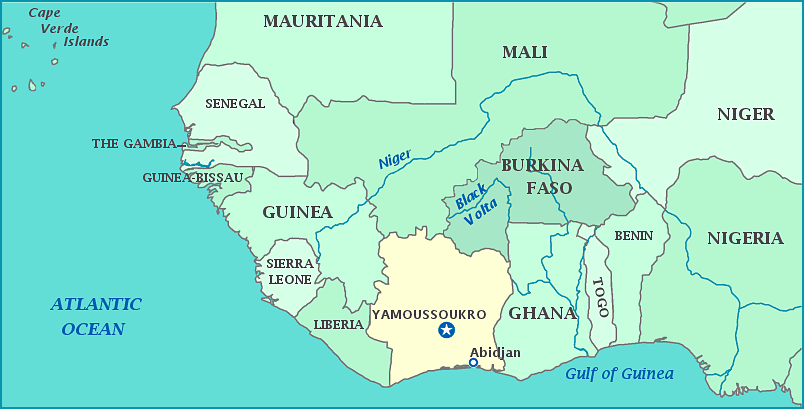Back
when I was in elementary and middle school, I learned this country as the Ivory
Coast. Now, they prefer the
Francophone form of the name: Côte d’Ivoire. It lies in western Africa, surrounded by Liberia, Guinea,
Mali, Burkina Faso, Ghana, and the Gulf of Guinea.
The
country itself has been known more names than Puff Daddy (or P. Diddy, or whatever
he goes by now). The French and
the Portuguese were the main two Europeans exploring the area (and by
exploring, I mean claiming and exploiting), and both have referred to this area
as Ivory Coast, reflecting what the major trade products were at that
time. Likewise, there was also a
“Grain Coast,” “Gold Coast,” and a “Slave Coast” as well. While there were other nicknames for
the area (“Teeth Coast” being one of the slightly creepier ones, unless you’re
a dentist), the name Ivory Coast prevailed. During the mid-1980s, the Ivoirian government insisted that
the official name of the country should be changed to Côte d’Ivoire (in French),
no matter the local language worldwide.
However, there are many people in the Anglosphere – including
journalists and media – who still call it Ivory Coast. (Not me, of course. Even
though I do have a copy of the AP Styleguide, and there’s no mention of it, so
maybe that’s their problem.)
Historians
believe that the earliest people in the area probably came from Berber caravans
from the north and settled into the area, dealing in salt, gold, spices,
slaves, and anything else they thought might be tradable. It was influenced by
the Ghana Empire and later by the Mali Empire. During the 19th century, the French started
making their way into Côte d’Ivoire and by the 1840s, the French had signed
treaties with certain tribal leaders and declared those areas as a French
protectorate. Soon, the French started to pour in and establish their place in
the country with the hopes of using the coastal regions as a strategic post in
the trade routes. Of course, their presence didn’t go without conflict. What
was happening in Côte d’Ivoire was very similar to what was happening in the
Colonial United States. Ivoirians at that time were, for all intents and
purposes, considered French citizens. They were expected to contribute to their
taxes and adhere to their laws, but they had no political voice. They were only
allowed to keep the aspects of their own culture as long as it was concordant
with what the French agreed to. So, naturally the Ivoirians fought back – with
independence as the ultimate result, which wouldn’t happen until 1960.
After
independence, the country grew to be French Africa’s most prosperous country.
It became a leading producer and exporter of pineapples, palm oil, coffee, and
cocoa (three of my favorites. I have no experience with palm oil since it’s a
little expensive here.). They did
have a coup in 1999, which led to a civil war in 2002. They finally managed to get in an
election in 2010, only to find it was riddled with fraud, which unfortunately
led to a second civil war in 2011.
 |
| Cocoa beans |
Lying
a little farther inland is the capital of Yamoussoukro (pronounced yah-muh-SOO-crow). However, the largest city in Côte
d’Ivoire is the coastal city of Abidjan (pronounced ah-bee-JOHN). Even though the official seat of
government takes place in Yamoussoukro, there are a lot of administrative
offices and embassies that are in Abidjan. The capital does claim to have the largest Christian church
in the world, according to the Guinness World Records: Basilica of Our Lady of
Peace of Yamoussoukro. The
building is 322,917 sq ft and 518 ft high. Yamoussoukro’s airport is also only
one of two in Africa that can accommodate the Concorde.
As
far as religion goes, the country is generally divided into three major
religions: Muslim, Christian, and animist: the majority being Muslim and
animist, and a smaller portion being Christian.
Because
of the French occupancy, the French language is the official language of Côte
d’Ivoire and serves as the language of business and education. French also serves as a lingua franca
since there are roughly 65-70 native languages that are also spoken in various
regions of the country, the largest being Dyula (also spelled Dioula or Jula,
part of the Mande language group).
Dyula is often used as a trade language in various West African
countries and is sometimes written in Arabic script, sometimes in Latin script,
and sometimes in the indigenous N’Ko script.
So,
as I prepare to make my return to West Africa to a country named after a trade
in something that can no longer be traded legally, I realize there’s something
about this region that I really enjoy, but I can never truly put my finger on
it. Perhaps because it’s seemingly what I think of as “African,” with a mix of
French influence? Perhaps its African Reggae? Perhaps its just knowing the people here are resilient –
looking at photos from Google Maps for some of these places, you HAVE to be
resilient to live there. Maybe all of it, maybe something I’m not sure of yet.
But I do know I like it. And the
recipes seem amazing at that. So,
that being said and in the best French I can muster, allons-y!
Up
next: holidays and celebrations




No comments:
Post a Comment